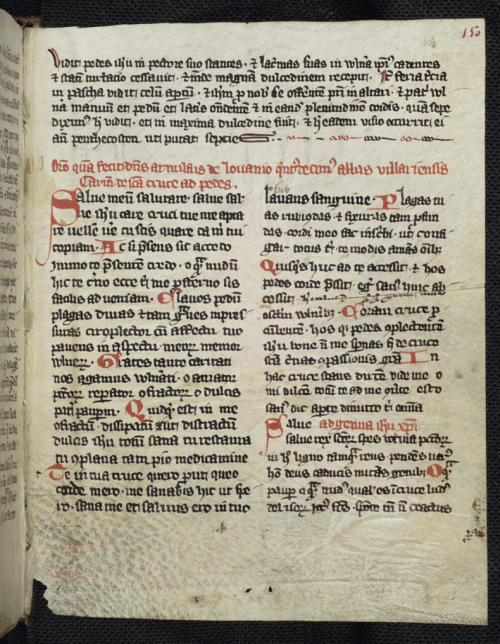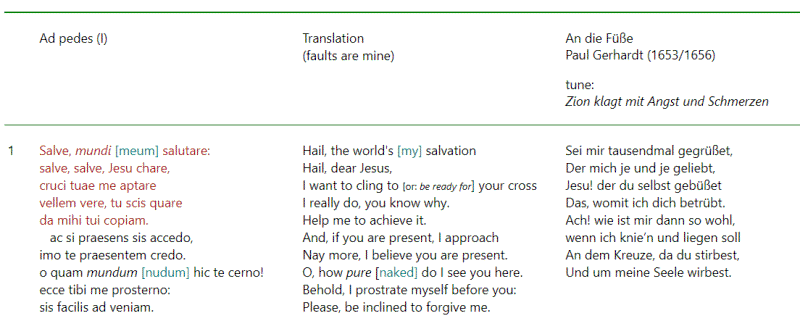Salve mundi salutare / O Haupt voll Blut und Wunden
Paul Gerhardt's famous Passion-hymn O Haupt voll Blut und Wunden , is de facto a versification of the seventh prayer of the early 13th century Latin prayer-cycle, known as 'Oratio Rhytmica (pseudo-Bernardi).
- In a hurry? jumpto the Latin text of that prayer, together with a litteral translation into English and Gerhardt's versification/paraphrase in German
- Got some time? Something about the source: a seven part prayer addressing (meditating on) Christ's wounded body parts.
- A translation of the entire prayer-cycle (7 body parts): Latin - English - German (P.Gerhardt).
The original prayer is an early 13th C prayer cycle meditating
the Crucified Christ, crucifixus. It's an expressive text with concrete physical
imagery (not graphic, as is often said. Just read!). Poetically impressive and innovating:
an intricate rhyme scheme "aabbc/ddeec",
and a clever use of repetition and sound. The first word: Salve
(greetings, hail, opening every new cycle) also is prayer:
Save me... 'salus', 'salutare', 'salutifera'
(last word of the 7th cycle). It used to be attributed to
Bernard of Clairvaux but the author
is Arnulf of Leuven (Louvain), an abbott (1240-1248) at the Cistercian abbey of
Villers (Duchy of Brabant, the romantic ruins can be seen near the city:
Villers-la Ville in the Belgian Province of Brabant
francophone).
It is explicitly attributed to Arnulf in a 1320
manuscript, now in Brussels Royal Library, originating from the monastery of
Villers and destined for the sisters of 'Vrouwenpark' (Cistercian nuns, living
in a monastery in Wezemaal, also Brabant). There the title (in red) reads
Oratio quam fecit arnulfus de lovanio quintusdecimus abbas
villariensis. Carmen de sancta cruce ad pedes.
(Prayer, made by Arnulf of Louvain, 15th abt of Villers. Song about the holy
cross, to the feet') So
at least the first cycle is ascribed to Arnulf.
Generally accepted though is his authorship of 5 of 7 cycli. The prayer is a
mediation 'at the cross' (crucifix), concentrating on Christ's wounded
body parts, from toe to top, 'extracting' spiritual blessing from it,
according to the scheme: he suffered propter nos but also pro
nobis. (resp. corresponding with the spiritual exercise of
contrition and gratitude)

Royal Library of Belgium (KBR) MS 4459–70, fols.
150r–152v (1320).- below folio 150r

Reconstruction of the abbay of Villers (now a
ruin, near Villers-la-ville).
The bulk of the poem will be his, but there is reasonable doubt about the cycle 'Ad pectus/Ad cor'. Only 10 lines of ad pectus are in the oldest manuscripts, remaining so until the end of the 15th C. Poetically the cycle Ad cor appears to be the odd one out: It doesn't begin with the keyword 'Salve' (as all others do). Also, many of the verses that àre present in the oldes manuscripts are metrically imperfect (the rhyme of the double verse (2x5) is aabbc/ddeec). Finally: 1240 is a bit early for the 'cult of the Holy Heart'. In late 15th C: manuscripts and editions we find both sections, but often rearranged, interpolated, with additions, corrected, emended, etc..
So: the first 4 prayers (pedes, genua, manus, latus) are Arnulf's. I also credit him for the 7th prayer cycle (ad vultus), because rhyme and metre are perfectly in line and tune with the first four. The cycles pectum/cor later elaborations. One pertinent caveat: The 7th cycle did originally not begin with the now worldfamous Salve caput cruentatum ("O Haupt voll Blut und Wunden"), but with Salve Iesu reverende, quite a difference in imagery and atmosphere! The text I publish juxtaposes the 'common' Latin text (becoming the predominant texttradition ca. 1500) of the hymn, with Paul Gerhardts versification (published in Praxis Pietatis Melica (ed. J. Crüger, Berlin), edition 1653 (partial), 1656 (complete). I added an English translation. If the original Ms. from Villers, dated ca. 1320, differed significantly from the familiar text I added the original phrasing in color. This only in the carmina 1-4 and 7 (For 5 and 6 this is impossible within the format chosen).
Rhythmica oratio
Ad unum quodlibet membrorum Christi patientis et a cruce pendentis
This is the traditional title (Opera Omnia of St. Bernard). The
original title in the oldest Ms. (ca. 1320) differs.
The original (Ms. from Villers,
see image above, ca. 1320) differs from the common text:
Oratio quam fecit dominus arnulfus de lovanio
quintusdecimus abbas villariensis
Carmen de sancta cruce ad pede
Click on the image below, to read
the entire text (all 7 sections) with translations
